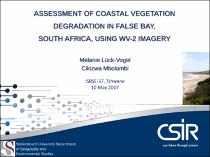 ResearchSpace
ResearchSpace
Assessment of coastal vegetation degradation in False bay, South Africa, using WV-2 imagery
JavaScript is disabled for your browser. Some features of this site may not work without it.
- ResearchSpace
- →
- Research Publications/Outputs
- →
- Conference Publications
- →
- View Item
| dc.contributor.author |
Lück-Vogel, Melanie

|
|
| dc.contributor.author |
Mbolambi, C

|
|
| dc.date.accessioned | 2017-06-07T08:05:24Z | |
| dc.date.available | 2017-06-07T08:05:24Z | |
| dc.date.issued | 2017-05 | |
| dc.identifier.citation | Lück-Vogel, M. and Mbolambi, C. 2017. Assessment of coastal vegetation degradation in False bay, South Africa, using WV-2 imagery. International Symposium of Remote Sensing of the Environment, CSIR ICC, Pretoria, 8-12 May 2017 | en_US |
| dc.identifier.uri | http://hdl.handle.net/10204/9259 | |
| dc.description | International Symposium of Remote Sensing of the Environment, CSIR ICC, Pretoria, 8-12 May 2017 | en_US |
| dc.description.abstract | Vegetation of the coast around the world fulfils an important role. It acts as a buffer against the impacts from the oceans such as waves and wind and protects the coastal hinterland from wind-blown sand and coastal erosion. However, due to the increasing pressure those coastal environments are experiencing from urban encroachment, pollution and direct usage impacts e.g. through trespassing, the intactness of coastal vegetation frequently is being impaired. As a result, its capacity to function as a coastal protection decreases. Monitoring and management of coastal vegetation belts is therefore of utmost importance, in particular in urbanised and industrialised areas where the hinterland hosts infrastructure of enormous economic value and importance. However, the assessment of coastal vegetation condition is frequently difficult, due to the large extent and frequently inaccessibility of the zone. Furthermore, in many countries such as South Africa, there is a scarcity of coastal vegetation expert to perform the task locally. Therefore remote sensing holds a huge potential for coastal vegetation condition assessment. In the work presented here, the use of WorldView-2 imagery was investigated for assessing the intactness of a stretch of coastal vegetation in the Municipal area in Cape Town. In an object-based approach, a decision tree classification was developed to identify pristine, slightly, moderately and severely degraded Cape Flats Dune Strandveld vegetation as well as areas infested with alien Acacia species in the vicinity of Khayelitsha, one of the fastest growing settlements in the region. Overall accuracies of >80% show that the results hold promise for being a useful tool for assessing the degree of intactness of coastal Strandveld vegetation. This would provide a valuable tool for environmental managers for monitoring and managing natural coastal zones and their functionality. | en_US |
| dc.language.iso | en | en_US |
| dc.relation.ispartofseries | Worklist;19055 | |
| dc.subject | Coast | en_US |
| dc.subject | Vegetation degradation | en_US |
| dc.subject | WorldView-2 | en_US |
| dc.subject | False Bay | en_US |
| dc.title | Assessment of coastal vegetation degradation in False bay, South Africa, using WV-2 imagery | en_US |
| dc.type | Conference Presentation | en_US |
| dc.identifier.apacitation | Lück-Vogel, M., & Mbolambi, C. (2017). Assessment of coastal vegetation degradation in False bay, South Africa, using WV-2 imagery. http://hdl.handle.net/10204/9259 | en_ZA |
| dc.identifier.chicagocitation | Lück-Vogel, Melanie, and C Mbolambi. "Assessment of coastal vegetation degradation in False bay, South Africa, using WV-2 imagery." (2017): http://hdl.handle.net/10204/9259 | en_ZA |
| dc.identifier.vancouvercitation | Lück-Vogel M, Mbolambi C, Assessment of coastal vegetation degradation in False bay, South Africa, using WV-2 imagery; 2017. http://hdl.handle.net/10204/9259 . | en_ZA |
| dc.identifier.ris | TY - Conference Presentation AU - Lück-Vogel, Melanie AU - Mbolambi, C AB - Vegetation of the coast around the world fulfils an important role. It acts as a buffer against the impacts from the oceans such as waves and wind and protects the coastal hinterland from wind-blown sand and coastal erosion. However, due to the increasing pressure those coastal environments are experiencing from urban encroachment, pollution and direct usage impacts e.g. through trespassing, the intactness of coastal vegetation frequently is being impaired. As a result, its capacity to function as a coastal protection decreases. Monitoring and management of coastal vegetation belts is therefore of utmost importance, in particular in urbanised and industrialised areas where the hinterland hosts infrastructure of enormous economic value and importance. However, the assessment of coastal vegetation condition is frequently difficult, due to the large extent and frequently inaccessibility of the zone. Furthermore, in many countries such as South Africa, there is a scarcity of coastal vegetation expert to perform the task locally. Therefore remote sensing holds a huge potential for coastal vegetation condition assessment. In the work presented here, the use of WorldView-2 imagery was investigated for assessing the intactness of a stretch of coastal vegetation in the Municipal area in Cape Town. In an object-based approach, a decision tree classification was developed to identify pristine, slightly, moderately and severely degraded Cape Flats Dune Strandveld vegetation as well as areas infested with alien Acacia species in the vicinity of Khayelitsha, one of the fastest growing settlements in the region. Overall accuracies of >80% show that the results hold promise for being a useful tool for assessing the degree of intactness of coastal Strandveld vegetation. This would provide a valuable tool for environmental managers for monitoring and managing natural coastal zones and their functionality. DA - 2017-05 DB - ResearchSpace DP - CSIR KW - Coast KW - Vegetation degradation KW - WorldView-2 KW - False Bay LK - https://researchspace.csir.co.za PY - 2017 T1 - Assessment of coastal vegetation degradation in False bay, South Africa, using WV-2 imagery TI - Assessment of coastal vegetation degradation in False bay, South Africa, using WV-2 imagery UR - http://hdl.handle.net/10204/9259 ER - | en_ZA |





